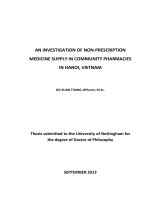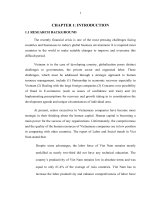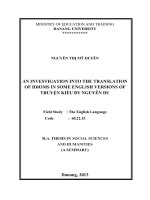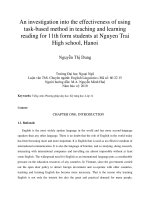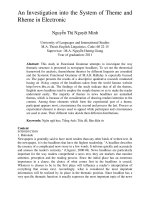An investigation of the polysemy of ‘open-close’ in english and ‘mỡ-đóng’ in vietnamese (from the cognitive perspective)
Bạn đang xem bản rút gọn của tài liệu. Xem và tải ngay bản đầy đủ của tài liệu tại đây (1.92 MB, 9 trang )
An investigation of the polysemy of
‘open/close’ in english and ‘mỡ/đóng’ in
vietnamese (from the cognitive perspective)
Bùi Thị Ngọc
Trường Đại học Ngoại Ngữ
Luận văn ThS. Chuyên ngành: English Linguistics; Mã Số: 60 22 15
Người hướng dẫn: Assoc. Prof. Dr. Trần Hữu Mạnh
Năm bảo vệ: 2010
Abstract: The overall aim of this research is to advance an understanding of polysemy in the
semantic field of the two verbs open and close in English and Vietnamese from cognitive
perspective.Specifically, a review of all related theoretical foundation is done in the first chapter,
serving as a background for the study to be carried out in the rest of the part. Particularly, the
first chapter displays my understanding of contrastive analysis, verbs, cognitive linguistics,
cognitive semantics and polysemy. Chapter 2 – Methodology – describes the methods and the
research procedures of the current study. Particularly, it describes the data collection in which
considerations in selecting materials and the sources of data are presented. Additionally, a
description of data analysis is also presented.Chapter 3 – Data Analysis– contains the core part of
the study. It presents, analyzes and synthesizes data collected. This chapter applies the theoretical
framework that is established in chapter 2 into analyzing the meanings of the two verbs
open/close and find out Vietnamese equivalents of these English verbs. Although there appear to
be some differences in the meanings and in the way in which these languages express meanings,
especially different non-prototypical extended meanings, these two languages share the majority
of them. And although the same meanings are expressed in different languages, the way in which
these different languages convey such meanings can be different.Accordingly, our findings are
supposed to be worthwhile to those who are interested in the field of cognitive semantics in
general and polysemy in particular
Keywords: Tiếng Anh; Động từ; Ngữ nghĩa học; Tiếng Việt
Content:
4
TABLE OF CONTENTS
PART A: INTRODUCTION 1
1. RATIONALE OF THE STUDY 1
2. SCOPE OF THE STUDY 1
3. OBJECTIVES OF THE STUDY 1
4. RESEARCH QUESTIONS 2
5. ORGANIZATION OF THE STUDY 2
PART B: DEVELOPMENT 4
CHAPTER I: LITERATURE REVIEW 5
1.1. AN OVERVIEW ON CONTRASTIVE ANALYSIS 5
2.2. A BRIEF DESCRIPTION OF VERBS 7
2.2.1. Verbs in English 7
2.2.2. Verbs in Vietnamese 8
3.3. COGNITIVE LINGUISTICS 9
3.3.1. Definition of terms 9
3.3.2. Major principles of cognitive linguistics 10
3.4. COGNITIVE SEMANTICS 10
3.4.1. Definition 10
3.4.2. Guiding principles of cognitive semantics 11
3.5. POLYSEMY 13
3.5.1. The traditional treatment of polysemy 13
3.5.2. Polysemy in cognitive linguistics 14
3.5.3. Summary 15
CHAPTER 2: METHODOLOGY 16
2.1. RESEARCH QUESTIONS 16
2.2. RESEARCH DESIGN AND METHOD 16
2.3. METHOD AND SOURCES OF THE LANGUAGE MATERIAL 17
2.3.1. Sources of the language material 17
5
2.3.2. Method of data collection 18
2.4. ANALYTICAL FRAMEWORK 18
CHAPTER 3: DATA ANALYSIS 20
3.1. THE POLYSEMY OF OPEN/CLOSE IN ENGLISH 20
3.1.1. Prototypical and non-prototypical meanings of ‘open/close’ 20
3.1.1.1 .Physical meanings of ‘open’ and ‘close’ 20
3.1.1.1.1. Physical meanings of the verb ‘open’ 20
3.1.1.1.2. Physical meanings of the verb ‘close’ 21
3.1.1.2. Non-prototypical extended meanings of ‘open/close’ 22
3.1.1.2.1. Non-prototypical extended meanings of the verb ‘open’ 22
3.1.1.2.2. Non-prototypical extended meanings of the verb ‘close’ 24
3.1.1.3. Summary 25
3.1.2. Encyclopaedic knowledge and meanings of ‘open/close’ 26
3.1.3. Radial category of ‘open/close’ 29
3.2. THE ENGLISH VERBS ‘OPEN/CLOSE’ AND THEIR VIETNAMESE
EQUIVALENTS 30
3.2.1. ‘Open/close’ in English corresponds to ‘mở/đóng’ in Vietnamese 31
3.2.1.1. ‘Open’ in English corresponds to ‘mở’ in Vietnamese 31
3.2.1.2. ‘Close’ in English corresponds to ‘đóng’ in Vietnamese 32
3.2.2. Some other Vietnamese equivalents of the English verbs ‘open/close’ 33
3.2.2.1. Some other Vietnamese equivalents of the English verb ‘open’ 33
3.2.2.1. Some other Vietnamese equivalents of the English verb ‘close’ 35
3.3. SIMILARITIES AND DIFFERNENCES BETWEEN ‘OPEN/CLOSE’ IN ENGLISH
AND ‘MỞ /ĐÓNG’ IN VIETNAMESE 37
3.3.1. Similarities 37
3.3.2. Differences 39
3.4. SUMMARY 39
PART C: CONCLUSION 41
6
1. CONCLUSIONS 41
2. IMPLICATIONS 42
3. LIMITATIONS OF THE RESEARCH AND SUGGESTIONS FOR FURTHER
STUDY 43
REFERENCES 44
7
PART A: INTRODUCTION
1. RATIONALE OF THE STUDY
I had some troubles with the self-referential nature of the material. Since the subject is the
"meaning of meaning" at various levels, it's easy to become confused and fall into a "black
hole" where text seems meaningless. Polysemy is the term widely used in semantic analysis
to describe the situation in which a word has two or more related meanings. No matter how
simple this definition seems to be, polysemy is not a clear-cut concept. For decades, linguists
from different universities have been trying to give a sound account of what polysemy is and
how it can be accounted for. Although polysemy is at the moment a hot topic in
cognitive and computational linguistics, unfortunately, it is still true that polysemy remains
a somehow muddy field in linguistic research.
Despite this, I feel the self struggle to construct this thesis to try and represent my learning as
a result of interacting with a wide diversity of texts has been a rewarding one. It has helped
me develop polysemy in my mind as a referent to apply to my own day-to-day practices and
research in communication, teaching and learning.
2. SCOPE OF THE STUDY
Within a short time and with limited reference materials, it would be too ambitious for this
small-scaled study to cover the polysemy of all kinds of verbs, a broad field and the most
complex part of speech. Therefore, the study is limited to investigating the polysemy of the
two verbs ‘OPEN’ and ‘CLOSE’ with their Vietnamese equivalents within cognitive
semantic theoretical framework. The study focuses on displaying some major principles of
cognitive linguistics in general and cognitive semantics in particular which are applied to
explore the meanings of these two verbs.
3. OBJECTIVES OF THE STUDY
Due to time limitation, the study aims to primarily seek for evidences of the polysemy of the
two verbs open/close and their Vietnamese equivalents from cognitive perspective. More
specifically, it focuses on:
- displaying major notions of cognitive semantics
- uncovering a semantic description of the English verbs “ open/close” in light of
cognitive semantics.
8
- investigating potential Vietnamese equivalents of the English verbs “open/close”.
- finding out the similarities and differences of these two verbs from cross-linguistic
point of view.
- providing pedagogical implications for teaching and learning as well as language
research.
More detailed explication as how the aforementioned objectives have been formulated and
how these objectives can be attained is specified in chapter 2: Methodology.
4. RESEARCH QUESTIONS
On the basis of the abovementioned aims and objectives, the study is conducted to answer the
following questions:
(1) From a cognitive semantic perspective, what meanings do the English
verbs ‘open/close’ have? How are they variedly used in this language?
(2) What are potential Vietnamese equivalents of the English verbs
‘open/close’ in various senses?
(3) How are these verbs similar and different between English and
Vietnamese in the light of cognitive semantics?
5. ORGANIZATION OF THE STUDY
The study is divided into three main parts: Part A is the Introduction to the study. Part B is
the Development with the three chapters. Part C is the Conclusion.
Part A discusses the rationale, the scope of the study, the objectives of the study,
methodology used in the study and the organization of the study.
Part B includes three chapters as follows;
- Chapter I is Literature Review which presents all related theoretical background that
precedes and necessitates the formation of my research: an overview on contrastive
analysis, a brief description of verbs, cognitive semantics and polysemy.
- Chapter II – Methodology – describes the research procedures that have been utilized
in the study.
- Chapter III – Data Analysis – contains the core part of the study. It presents, analyzes
and synthesizes data collected and gives some findings and discussions.
The Conclusion part summarizes the major findings and implications about the polysemy of
the verbs ‘open’ and ‘close’ within cognitive semantic theoretical framework and suggestions
for further study.
50
REFERENCES
In Vietnamese
1. Cao Xuân Hạo (1991), Sơ thảo ngữ pháp chức năng, Nxb Giáo dục.
2. Diệp Quang Ban (2001), Ngữ pháp tiếng Việt, Nxb Giáo dục.
3. Diệp Quang Ban & Hoàng Văn Thung (2002), Ngữ pháp tiếng Việt, volume1, Nxb Giáo
dục.
4. Lê Biên (1999), Từ loại tiếng Việt hiện đại, Nxb Giáo dục.
5. Lý Toàn Thắng (2006), Ngôn ngữ học tri nhận, từ lý thuyết đại cương đến thực tiễn tiếng
Việt, Nxb Khoa học Xã hội, Hà Nội.
6. Trần Ngọc Thêm (2004), Tìm về bản sắc văn hóa Việt Nam, Nxb Tổng hợp, Tp Hồ Chí
Minh.
In English
7. Barcelona, A. 1997. Clarifying and Applying the Notions of Metaphor and Metonymy
within Cognitive Linguistics. Atlantis XIX.1: 21-48.
8. Biber D. et al (2007), Grammar of spoken and written English. London: Longman
9. Connor, U (1996), Contrastive Rhetoric: Cross-Cultural Aspects of second-language
writing. Cambridge University Press
10. Croft, W. & Cruse, A. (2004), Cognitive Linguistics. Cambridge: Cambridge University
Press
11. Crystal, D. 1991. A Dictionary of Linguistics and Phonetics. Oxford: Blackwells.
12. Evans, V. and Green, M. (2006), Cognitive Linguistics: An Introduction. Edinburgh:
Edinburgh University Press.
13. Evans et al. (2007), The Cognitive Linguistics Reader. London: Equinox Publishing.
14. Geeraerts, D. (1999), Cognitive Linguistics: Foundations, Scope and Methodology.
Berlin: Mouton de Gruyter.
15. Geeraerts, D. & Cuyckens (2007), Oxford handbook of Cognitive Linguistics. Oxford:
Oxford University Press.
16. Halliday, M.A.K (1999), An Introduction to Functional Grammar. Oxford: Oxford
University Press.
17. James, C. (1980), Contrastive Analysis, London: Longman
18. Johnson, M. 1987. The Body in the Mind. Chicago: Chicago University Press.
19. Lakoff, G. 1987. Women, Fire and Dangerous Things. What Categories Reveal about the
Mind. Chicago and London: Chicago University Press.
51
20. Lakoff, G. and M. Johnson. 1980. Metaphors We Live by. Chicago and London: Chicago
University Press.
21. Lakoff, G. and M. Johnson. 1999. Philosophy in the Flesh. The Embodied Mind and Its
Challenge to Western Thought. New York: Basic Books.
22. Langacker, R. W. (1987), Foundations of Cognitive Grammar, Volume I: Theoretical
Prerequisites. Stanford: Stanford University Press.
23. Langacker, R. W. (1990), Concept, Image, and Symbol. Berlin: Mouton de Gruyter.
24. Langacker, R. W. (1991a), Foundations of Cognitive Grammar, Volume II: Stanford:
Stanford University Press.
25. Langacker, R. W. (1999), Grammar and Conceptualization, Berlin: Mouton de Gruyter.
26. Quirk et al. (1985), A comprehensive Grammar of the English Language. London:
Longman
27. Talmy, L. (2000), Toward a Cognitive Semantics. Volume I: Concept Structuring
Systems, Cambridge, Massachusetts: MIT Press.
28. Talmy, L. (2000), Toward a Cognitive Semantics. Volume II: Typology and Process in
Concept Structuring, Cambridge, Massachusetts: MIT Press.
29. Taylor, J. R. (2002), Cognitive Grammar. Oxford: Oxford University Press
30. Taylor, J. R. (1991), Linguistic Categorization. Prototypes in Linguistics Theory. Oxford:
Oxford University Press.
31.
32.
33.
34.
35.
36.
52
SOURCE OF DATA
1.
2.
3.
4. English- Vietnamese Dictionary (2006)
5. Stephenie Meyer, (2005), Twilight
6. Stephenie Meyer, (2007), Eclipse
7. Jane Austen, (2005), Pride and Prejudice
8. Tịnh Thủy, (2007), Chạng Vạng
9. Tịnh Thủy, (2009), Nhật Thực
10. Diệp Minh Tâm, (2009), Kiêu hãnh và Định Kiến


